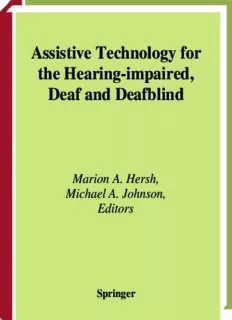
Assistive Technology for the Hearing-impaired, Deaf and Deafblind PDF
Preview Assistive Technology for the Hearing-impaired, Deaf and Deafblind
Assistive Technology for the Hearing-impaired, Deaf and Deafblind Marion A. Hersh, Michael A. Johnson, Editors Springer Assistive Technology for the Hearing- impaired, Deaf and Deafblind Springer London Berlin Heidelberg NewYork HongKong Milan Paris Tokyo Marion A. Hersh, Michael A. Johnson (Eds.) withConnyAndersson,DouglasCampbell,Alistair Farquharson,StephenFurner,JohnGill,AlanJackson, JayLucker,KeithNolde,ErhardWernerandMikeWhybray Assistive Technology for the Hearing-impaired, Deaf and Deafblind 1 3 MarionA.Hersh,MSc,PhD DepartmentofElectronicandElectricalEngineering,UniversityofGlasgow, Glasgow,G128LT,UK MichaelA.Johnson,MSc,PhD DepartmentofElectronicandElectricalEngineering,UniversityofStrathclyde, Glasgow,G11QE,UK BritishLibraryCataloguinginPublicationData Assistivetechnologyforthehearing-impaired,deafand deafblind 1.Self-helpdevicesforpeoplewithdisabilities2.Hearing impaired3.Hearingaids–Designand construction I.Hersh,MarionA.II.Johnson,MichaelA.(MichaelArthur), 1948- 617.8’9 ISBN1852333820 LibraryofCongressCataloging-in-PublicationData Assistivetechnologyforthehearing-impaired,deafanddeafblind/MarionA.Hersh, MichaelA.Johnson(eds),withConnyAndersson...[etal.]. p.cm. Includesbibliographicalreferencesandindex. ISBN1-85233-382-0(alk.paper) 1.Deaf--Meansofcommunication.2.Communicationdevicesforpeoplewith disabilities.3.Deaf--Meansofcommunication--Technologicalinnovations.4. Communicationdevicesforpeoplewithdisabilities--Technologicalinnovations.I.Hersh, MarionA.,1956-II.Johnson,MichaelA.,1948- HV2502.A8752003 362.4'283--dc21 2002044538 Apartfromanyfairdealingforthepurposesofresearchorprivatestudy,orcriticismorreview,as permitted under the Copyright, Designs and Patents Act 1988, this publication may only be reproduced,storedortransmitted,inanyformorbyanymeans,withthepriorpermissioninwritingof thepublishers,orinthecaseofreprographicreproductioninaccordancewiththetermsoflicences issuedbytheCopyrightLicensingAgency.Enquiriesconcerningreproductionoutsidethoseterms shouldbesenttothepublishers. ISBN1-85233-382-0 Springer-VerlagLondonBerlinHeidelberg amemberofBertelsmannSpringerScience+BusinessMediaGmbH ©Springer-VerlagLondonLimited2003 Theuseofregisterednames,trademarks,etc.inthispublicationdoesnotimply,evenintheabsenceof aspecificstatement,thatsuchnamesareexemptfromtherelevantlawsandregulationsandtherefore freeforgeneraluse. Product liability: The publisher can give no guarantee for information about drug dosage and applicationthereofcontainedinthisbook.Ineveryindividualcasetherespectiveusermustcheckits accuracybyconsultingotherpharmaceuticalliterature. TypesetbyIanKingstonEditorialServices,Nottingham,UK PrintedandboundintheUnitedStatesofAmerica 28/3830-543210 Printedonacid-freepaper SPIN10781975 Formymotherandfather MarionA.Hersh Thatthisbookmightinspiremytwoyoungfriends,HollyandJoe MichaelA.Johnson This page intentionally left blank Preface Affirmativelegislativeactioninmanycountriesnowrequirespublicspacesto beaccessibleandserviceproviderstochangeorintroducepractices,policies, orproceduresthatallowequalaccessibilitybydisabledpeople.Althoughthis isofteninterpretedasaccessforwheelchairusers,suchlegislationalsocovers peoplewithvisionorhearingimpairments.Inthesecasesitisoftentheprovi- sion of advanced technological devices that enable people with sensory impairments to enjoy the theatre,cinema,a political meeting or a religious meetingtothefull.Hearing-impairedanddeafpeoplehavebeenespecialben- eficiariesof thisslow,but growing,technological provision,and thisbook is aboutthisparticularbranchofassistivetechnology. Thefieldof assistivetechnologyhassteadilygrown,drivenbythedesireto provide disabled people with equal access to the facilities and products of society and to provide an enhanced quality of life for this community group. Manydifferentengineeringideasanddisciplineshavebeenusedtoproducethe technologicalsolutionsrequired.However,therehavebeenfew,ifany,system- aticattemptstodrawtogetherthethemesof assistivetechnologyandcreatea coherenttechnologicalandengineeringdiscipline.Itistruethatorganisations liketheRehabilitationEngineeringSocietyofNorthAmerica(RESNA)andthe AssociationfortheAdvancementof AssistiveTechnologyinEurope(AAATE) try to present a cohesive programme for assistive technology,but our experi- encehasbeenthat,althoughmanyengineersareactiveintheseorganisations, assistivetechnologyhasnotyetbecomepartofmainstreamengineering. Partoftheproblemissimplythelackofacoherenteducationalframework forinvolvingengineersintheassistivetechnologyfield.Thisisnottosaythat engineersdonotwishtostudythesubject,sinceourexperienceisthatyoung undergraduate and postgraduate engineers relish the idea of trying to solve problems in assistive engineering.Indeed,there are some really challenging technicalproblemsstilltobetackled.Whatismissingarebooksthatdemon- stratethatitispossibletobringtogetherthethemesofhumanphysiology,fun- damental engineering principles,design principles,engineering technology, andhumanend-userissues(suchasethics)tomakeacoherentcoursethatcan contribute to the higher education of electrical and mechanical engineers. Thisparticularcollaborativebookisanattempttodemonstratejusthowthis might be accomplished for the assistive technology needed by the hearing impairedanddeafcommunity.Thebookisenvisagedasthefirstofaseriesof threetextsdealing,inturn,withassistivetechnologiesanddevicesforpeople withhearing,visionandmobilityimpairments. vii viii Preface Inparallelwithdevelopingthistextbook,wehavebeenpioneeringtheintro- ductionofacoursemoduleonAssistiveTechnologyintheElectronicandElec- trical Engineering degrees at our respective universities. The experience gained in developing the educational framework has also been fed into the bookasitprogressed.Theconsequencehasbeenastrongeditorialsteeronthe various chapters to give the type of information required in degree courses and the strong engineering approach in the book. This particular book is abouttheapplicationofelectricaltechnologytoallaspectsofcommunication anddailylivingforthosepeoplewithhearingimpairments.Thefirstchapter, onphysiologicalaspectsofhearing,setsthebackgroundforthevarioustech- nological areas, namely hearing-aid development, induction and infrared communicationsforpublicspaces,andaccessibility.Thebookthencontinues withfacilitatingtechnologiesanddevicesfortelephonyanddailyliving.The penultimatechaptertakesalookatassistivetechnologyfordeafblindpeople,a really challenging area with a number of unsolved research questions. The final chapter of the book presents a basic introduction to human end-user issuesandethics,aswellasthedistributionofdevicestoendusers.Thisisnota long chapter, but it deals with topics that are often omitted from existing engineeringcourses. Webelievewesetourselvesambitiousobjectivesinwritingthisbook,which couldnothavebeenaccomplishedwithoutthecooperationandenthusiasmof ourcollaboratingauthors.Wewouldliketothankthemallfortheirhelpand patience in seeing the project come to fruition.We have been lucky to meet manyofourcollaboratorsattheConferenceandWorkshoponAssistiveTech- nologiesforVisionandHearingImpairment,whichweorganisewithinvalu- able European Union support (from the High Level Scientific Conference Programme), and this has given us the opportunity to discuss and debate togethermanyof theengineeringideasandtechniquesreportedinthebook. Needless to say,we have made many new friends in the process and gained many useful insights into assistive technology for people with hearing and vision impairments.We hope this book will inspire many new projects,new coursesandnewwaystoassistpeoplewithsensoryimpairments. MarionHershandMichaelJohnson Glasgow,Scotland,UK WhoShouldReadThisBook This book is designed to inform a wide range of current and future profes- sionals about basic engineering principles and the way these principles are turnedintoassistivetechnologydevices,thepossiblefuturetechnologydevel- opments,andthehumanend-useraspectsinassistivetechnologyforhearing- impairedanddeafpeople.Asfaraswehavebeenabletoascertain,thereareno othertextbooksforelectricalengineering,mechanicalengineeringandscien- tificprofessionalsonthistechnologicalareaatthisdepthorwiththishigher educationalapproach.Thisisexpectedtochangeaslegislativepressuresdrive the need for more engineering and social professionals to become aware of Preface ix thesetechnologies.Similarly,wehavenotbeenabletofindanyundergraduate course texts of adequate detail and depth for the discipline of assistive tech- nology.Thus,wehopethisbookwillbewellplacedtomeetthisneed,asithas beendesignedtobereadbyelectricalengineeringundergraduatesasacourse bookortosupplementexistingcourses.Theauthorshavebeenencouragedto see many engineering undergraduates enjoy this type of material, and it is hoped that this enjoyment will fire the ingenuity of engineering students to find new and innovative ways to develop technology to support hearing- impairedanddeafpeople. AnOverviewoftheBook Thisbookprovidesdetailedcoverageofthefullrangeofassistivetechnologies usedtosupportdeaf andhearing-impairedpeople,includingstate-of-the-art techniques.Divisionintochaptersisbasedoneitherthetypeoftechnologyor the field of application.The following applications are discussed: audiology andassessmentofhearingloss,hearingaids,telecommunications,devicesfor dailylivinganddevicesfordeafblindpeople.Systemsanddevicesbasedonthe induction-looptechnologyandinfraredtechnologyarepresented.Toprovide a background to the technologies, particularly the hearing assessment and hearing-aidtechnologies,thefirstchapterdiscussesthephysiologyoftheear andcausesofdeafness. Thebookisdesignedsothateachchapterisself-containedandcanberead onitsown,thoughfamiliaritywiththematerialinChapter1willbeassumedin some of the other chapters. Each chapter is motivated by specific learning objectivesandcontainsanintroductiontothesubject,suchasthebasicprinci- plesof theunderlyingtechnologyortheapplicationarea.Thisisusuallyfol- lowedbyafulldiscussionoftheapplicationsofthetechnologytosupportthe hearingimpaired.Thechaptersclosewithsuggestionsforprojectsandrefer- ence to further reading sources, books, journal and conference papers and Web sites.There maybe manyprofessionalsforwhomthisisa newarea and who may not be familiar with the underpinning pedagogical engineering topicscoveredinthevariouschapters,soTable1isgiventoprovideanoutline planofthebookandthedisciplinesinvolved. EditorialResponsibilities TheconceptofthisbookoriginatedwithMarionHershandMichaelJohnson, whowerealsoresponsiblefortheoveralltaskofcollatingandintegratingthe variouscontributions.Thebookismoreaclosecollaborationbetweeneditors and chaptercontributorsthan the usual book of edited chaptersand papers. Thiswasnecessarytotryandobtainthestyleofatextbookonassistivetech- nologyforhearing-impairedanddeafpeople.
